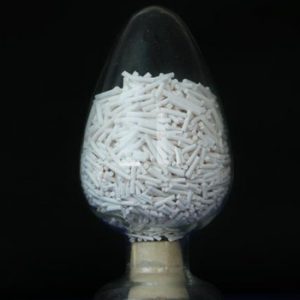High quality Light Hydrocarbons (C3-C5) Aromatization Catalyst
Email: zsm-5@zsm-5.cc

The light hydrocarbons (C3-C5) aromatization catalyst produced by our company adopts the high silicon zeolite with certain pore structure. Under a certain temperature, the catalyst can convert light hydrocarbons (C3-C5) to benzene, toluene, xylene and other aromatic components, while generating dry gas containing hydrogen, methane, ethylene, ethane and other components. The catalyst has a good aromatic selectivity and the coke regeneration rate is low. Meanwhile, it has good activity and stability. It has a long service life and can be regenerated.
Properties of Catalyst
|
Appearance |
white |
|
|
Particle size |
sphere |
Φ3-5mm |
|
strip |
Φ2.0*3-10mm |
|
|
Bulk density |
≥0.65-0.80g/cm3 |
|
|
Strength |
≥100N/cm |
|
|
Pore volume |
≥0.15ml/g(BET) |
|
|
Surface area |
≥220m2/g(BET) |
|
Technological Parameter
Reaction temperature: 460-520℃
Reaction pressure: 0.1-0.4Mpa
Weight hourly space velocity: 0.2-0.3h-1
Service life: more than 2 years
Technological Process
Reaction system
Using a fixed bed reaction method, it can operate continuously or intermittently. The reactive part contains a raw material preheating furnace and a fixed-bed reactor. The regeneration system is equipped with a regeneration gas heating furnace. During the continuous operation, each reaction runs in one reactor. The reaction in the reactor and
the catalyst regeneration conduct alternately, so that the whole operation stays in a continuous state
Separation of the products
The reaction products are made up of rich gas and liquid products. The rich gas enters into the absorption and stabilization system. After aromatization reaction, the aromatics content of liquid products is more than 90%, as the raw material is mixed light hydrocarbons.
Regeneration system
After the nitrogen and purified air (for supplement) from the system entering separately into the regeneration gas sub-tank in proportion for liquid separation, they enter into regeneration gas heat exchanger. After exchanging with circulating gas, they enter into regeneration gas furnace for heating up to the required temperature. At last, they go into the aromatization reactor, scorching from the top to the bottom from the top of the bed. The air should be supplied at any time according to the temperature variation of the reactor bed.
Welcome inquiry us zsm-5@zsm-5.cc
